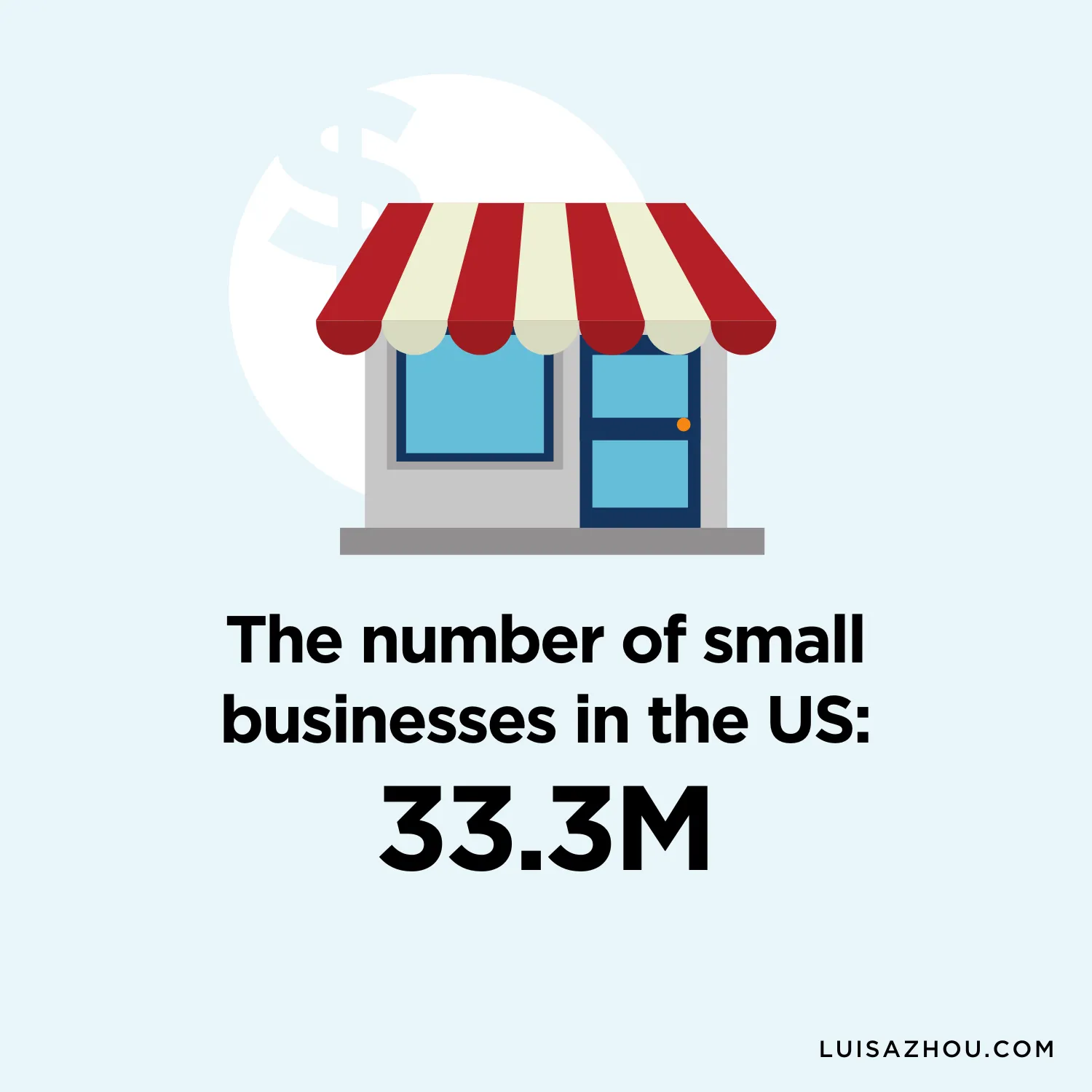Explore web search results related to this domain.
Every small business needs a little help. Check out these 36 easily implementable and highly effective strategies for growing your brand and boosting sales.
The unfortunate thing is that you need to think about growth all the time. The fortunate thing, is that there’s plenty of ways to think about it, and plenty of tactics you can experiment with. I’ve worked with hundreds of small businesses over the last 10 years, helping them execute everything from the most simple to the most detailed marketing strategies.Most recently I helped setup the SEO product at Australia’s largest marketing services provider for small businesses. So I understand some of the challenges that many of you have. In this guide I’m going to take you through 36 actionable growth strategies that you can learn from, and implement in your own business.It’s very easy to focus on nothing but your business, but remember we’re all human. Make time for yourself to unwind and relax. Nothing hinders the growth of a company more than the main person behind it getting burnt out. Look after yourself and most importantly, have fun 🙂 ... We break down how we grew our inbound traffic by 300% in just 6 months. The 5 Content Pillars That Drive 95% Of Our Inbound Leads · 95% of our new customers come from inbound marketing.Building solid scalable partnerships can help your business scale far beyond your own expectations #growthhacking


The latest news and updates in Business brought to you by the team at KTLA:
How many startups and small businesses have grown with digital marketing but failed to sustain it because they don’t have a strategy? If your situation is similar to any of the examples above, you’ve come to the right place. This blog teaches you how to create a digital marketing strategy that scales in congruence with your business growth...
Once you have a list of goals, you can establish corresponding small business marketing goals. Remember that these goals should be aligned with your business growth goals. It could be raising brand awareness in your new location. Put on your thinking cap and ask yourself, “What is marketing in business location #2 going to look like?” · The number of people you can target in a city, county or state is finite. So finding a new audience is an inevitable part of how to scale your business.We understand why digital marketing for small business to medium enterprise owners is about trying the most accessible or popular channels and seeing what works. “Fail early, learn fast” is most startups’ battle cry, right? But as the best digital marketing companies would advise, scalability is about failing smart. It’s about increasing your odds of success using strategic planning and critical thinking. Thus, wherever you are in your growth journey, you should define your marketing strategy well.Building on the digital marketing for small business example, let’s take your top performers and integrate other channels to generate more growth. For instance, let’s say you’re getting a lot of value from email marketing.Digital marketing can be adapted to the growth of companies of any size. But if you’re here to learn how to grow your small business and take it further with an agile approach, consider the following steps:

Once you start putting your product out into the world, you face a question that can be genuinely terrifying: is the thing that I'm selling good enough that people will actually pay for it?
As you scale your small business marketing, take a look at these 4 ways to use marketing automation to grow your business.Small scale marketing is personal, and people like personal. They increasingly want to support small businesses over giant behemoths.If you're like me, the result may be that you try to start marketing in the most impersonal ways possible, like running Facebook and Google Ads, to avoid the prospect of face-to-face rejection. Of course, even if you're braver than I, you may well decide to start with those major, digital advertising platforms anyway. There are good reasons to do so: they have immensely powerful targeting abilities and huge audiences that make it easy to scale your advertising as your business grows.Arguably more important is that when they do buy your product, they feel a real connection to you, and they'll be much more inclined to share your business with others. When I say start small, I mean be hands-on, engage with prospective customers directly, and show your products off to people who are likely to be passionate. Here are a few examples. Setting up a table and pitching your wares to folks passing by is the essence of starting small. Depending on what type of product or service you're selling, farmers' markets might work, or there may be less frequent events that are more domain-specific (for example, if you're starting a sportswear company, many marathons have vendor villages).


Internal functions include accounting, ... and marketing, which are also considered operational efficiencies and synergies. Economies of scale are an important concept for any business in any industry and represent the cost-savings and competitive advantages larger businesses have over smaller ...
Internal functions include accounting, information technology, and marketing, which are also considered operational efficiencies and synergies. Economies of scale are an important concept for any business in any industry and represent the cost-savings and competitive advantages larger businesses have over smaller ones.Management techniques and technology have been focusing on overcoming the limits to economies of scale for decades. Set-up costs are lower due to more flexible technology. Equipment is priced more closely to match production capacity, enabling smaller producers such as steel mini-mills and craft brewers to compete more easily. Outsourcing functional services makes costs more similar across businesses of various sizes. These functional services include accounting, human resources, marketing, treasury, legal, and information technology.Economies of scale are cost advantages reaped by companies when production becomes efficient.Most consumers don't understand why a smaller business charges more for a similar product sold by a larger company. That's because the cost per unit depends on how much the company produces. A company can create a diseconomy of scale when it becomes too large and chases an economy of scale.
What are the top small business marketing statistics and trends right now? Here are the newest SMB marketing facts.
AI adoption among small businesses is on the rise, with 40% leveraging generative AI tools such as chatbots and image generators, and 98% using software powered by AI. The top nine AI use cases for marketing include: ... At the same time, 83% of businesses see AI as a top priority. ... 91% of small businesses see AI as a critical tool for growth.These companies attract 55% more website visitors compared to businesses without blogs. Additionally, blogs help generate 67% more leads, demonstrating their role as a cornerstone of successful content marketing strategies. ... Luisa Zhou has helped thousands of students build and scale their own profitable online Freedom Business.How small business owners allocate their marketing budgets · The most effective marketing channels to drive growth21% of new businesses utilize AI, with 82% applying it to marketing tasks like content creation and market research. Additionally, 46% use AI to enhance sales processes. ... AI is proving to be a time-saver for small businesses. Statista reports that 39% of SMBs save 26–40 minutes per week through AI and automation, while 33% save over 40 minutes weekly. These efficiencies allow business owners to focus on growth-oriented activities while streamlining daily operations.


Around half of all small businesses ... overall growth of around 32,000 new businesses a year.5 · A survey by CB Insights indicates that finances are unsurprisingly the biggest cause of business closures, with 38% of startups failing as a result of being unable to secure financing or running out of existing funds. However, 35% also failed due to the lack of market demand and one-fifth due to their competition.4 · Breaking it down by industry, small businesses ...
Around half of all small businesses fail within five years, and around 65% by their tenth year of operation.22 Although around 595,000 businesses close each year in the U.S., 627,000 new businesses are created on average, which means there is a net overall growth of around 32,000 new businesses a year.5 · A survey by CB Insights indicates that finances are unsurprisingly the biggest cause of business closures, with 38% of startups failing as a result of being unable to secure financing or running out of existing funds. However, 35% also failed due to the lack of market demand and one-fifth due to their competition.4 · Breaking it down by industry, small businesses in healthcare and social assistance have the best success rate, with 85% of enterprises still operational after one year, putting the industry 5% above the national average survival rate.5Are you a small business owner and want to know facts about small businesses? Read our guide to find the small business statistics this year.The U.S. Small Business Administration defines a small business as a firm with revenue ranging from $1 million to over $40 million and an employee workforce of under 500.5 Based on the SBA’s definition, the 33.2 million small businesses in the United States make up 99.9% of all firms across the country.27 · These businesses form the backbone of the United States economy as not only a vital source of innovation and employment opportunities but also a huge driver of the nation’s financial growth.In addition to this, small businesses make up 43.5% of the country’s GDP and 35.6% of all private sector receipts — valued at roughly $13.3 trillion.29 · While specific metrics and measurements will vary by industry and business type, generally speaking, you can define a good growth rate for a small business as one that is higher than the growth rate of the economy as a whole.13

A digital marketing strategy is essential to any thriving business. See the tactics successful brands use and get inspired by campaigns that work.
Marketing or not, there are three parts to any strategy: ... Depending on the scale of your business, your marketing strategy may include several moving parts, each with different goals.Discover how to create a successful marketing strategy for your business to seize growth opportunities and boost revenue.A marketing strategy is a plan for reaching a specific marketing-related goal (or goals) in a focused and achievable way. It takes into consideration what your business is currently doing well and what you're missing regarding the objective you set, then developing tactics to help you meet your goal. If you run a small business, I get that you may not know how to jumpstart your strategy.While my main focus will be on organic growth and community building, I'll also run occasional paid ads to reach a broader audience. Set up an SOP for future strategies. Lastly, I would set up a Standard Operating Procedure to break my current strategy down to a step-by-step framework that would help me develop and roll out future campaigns a bit quicker. · Your strategy document will be very individual to your business, which is why it's almost impossible for us to create a one-size-fits-all digital marketing strategy template.
Validate your side hustle idea ... with a small audience. Invest in branding that helps you stand out, including a professional logo and consistent messaging. Automate repetitive tasks using tools like Mailchimp or QuickBooks, and delegate operations as your business grows. Tracking metrics such as customer acquisition cost and profit margins will help you make informed decisions. Reinvest profits into marketing, technology, or new product development to fuel growth...
Validate your side hustle idea by researching the market and testing it with a small audience. Invest in branding that helps you stand out, including a professional logo and consistent messaging. Automate repetitive tasks using tools like Mailchimp or QuickBooks, and delegate operations as your business grows. Tracking metrics such as customer acquisition cost and profit margins will help you make informed decisions. Reinvest profits into marketing, technology, or new product development to fuel growth.But not all side hustles are created equal, as some have limited growth potential, while others can scale into thriving businesses. A scalable side hustle is one that can grow beyond the time and effort you personally invest. Instead of being limited by trading time for money, scalable side hustles rely on systems, products, or processes that allow for growth. Key features of scalable side hustles include low overhead costs, repeatable processes, the use of technology for automation, and a product or service with high market demand.Print-on-demand businesses scale by offering new designs, expanding product categories, and running targeted marketing campaigns. Platforms like Printful make it easy to integrate with your online store. Curated subscription services are in high demand, offering everything from beauty products to niche snack boxes. This business model provides recurring revenue, which creates financial stability and predictable growth opportunities.Platforms like Shopify make it easy to start small, while scalability comes from expanding your product line, leveraging dropshipping, or investing in marketing strategies like SEO and paid advertising. Focusing on a niche market with strong demand can maximize your growth potential.
Another way to scale your small business is to sell products to customers outside the U.S. or import products internationally.
Growth and scaling opportunities typically require additional outputs so it’s important to have a solid business foundation and established operations in place before considering a growth strategy · In this article, we’ll explore how to scale your small business strategically so that it won’t take too much away from the bottom line.Make the most of influencer marketing. Arrange to have your product endorsed by an influencer. Influencers are individuals who have a large social media following and are seen as experts in a specific niche. This is a business strategy that can propel product sales. ... Another way to scale your small business is to sell products to customers outside the U.S.To help Oregon small businesses scale and bring innovative concepts to the marketplace, the Oregon SBDC helps companies prepare proposals for Small Business Innovation Research (SBIR) and Small Business Technology Transfer (STTR) grants through the Network’s partnership with VertueLab.Having valuable data at your fingertips is a surefire way to ensure that you’re making intelligent decisions when scaling your products-based business. The Oregon SBDC’s Market Research Institute provides market research to help companies identify growth opportunities, understand the competitive landscape, refine their business plans, and make more informed decisions.


Research found that small businesses tend to spend between 7% and 8% of their revenue on marketing, while startups may invest between 3% and 5% until they are more established. The Business Development Bank of Canada recommends B2B businesses allot between 2% and 5%, whereas B2C businesses should spend between 5%-10%. Clearly, some percentage makes sense to invest in marketing, just as you would with any other growth...
Research found that small businesses tend to spend between 7% and 8% of their revenue on marketing, while startups may invest between 3% and 5% until they are more established. The Business Development Bank of Canada recommends B2B businesses allot between 2% and 5%, whereas B2C businesses should spend between 5%-10%. Clearly, some percentage makes sense to invest in marketing, just as you would with any other growth-focused metric.While industry benchmarks can provide a general guideline, it’s important to understand that each business operates in its own context, with different target audiences, competitive landscapes, and growth strategies. By customizing your marketing budget based on these factors, you can optimize your spending and maximize the return on investment. For instance, consider a small e-commerce business that has just launched its online store.Understand the factors that influence marketing budget allocation and find out industry benchmarks for spending on marketing.Clinging to non-scalable approaches can choke growth potential. Growing pains are surmountable with a willingness to evolve. When it comes to determining the ideal allocation of marketing spend, adopting a revenue-based approach can provide valuable insights. A revenue-based marketing budget is a strategic framework that allocates a certain percentage of gross revenue specifically for marketing activities. This method ensures that businesses allocate their marketing funds in proportion to their overall revenue, allowing for a more balanced and sustainable approach.

Learn about small businesses’ contributions to the economy and the unique challenges they face.
Companies are also looking at emerging technologies like AI to add to their arsenal of digital tools to compete and expand their business. Nearly all (95%) U.S. small businesses report that they use at least one technology platform. ... Accessing growth capital is a perpetual challenge for small businesses.Historically, startups and the smallest businesses (0-4 employees) use personal savings to finance their business. Businesses in growth mode and larger small businesses primarily rely on credit cards, community banks, and credit unions to fund their operations.The largest small businesses rely on national banks for growth capital.Small Business A Majority of Small Businesses Say Regulations Hinder Growth By Thaddeus Swanek

Many entrepreneurs don't recognize the difference between growth and scaling in business terms, but there’s a crucial distinction between the two.
Many people use the words growth and scaling in business interchangeably, but there's a crucial difference. We explain.marketing automation tools that helped them market more efficiently to a larger audience. The company’s gains outpaced its losses, meaning it didn't just grow — it grew at scale. As you launch a new business, you should already be thinking about scaling. If you simply continue trying to increase your revenue by adding more resources with a corresponding increase in costs, your growth is likely to stagnate.Many people use these words interchangeably to describe a company that gets bigger, gobbles up more market share, and makes more and more money. But there’s a crucial difference between growing and scaling in business terms, and it’s important to speak precisely about kind of growth you have in mind and to convey what's really happening with the business.“Scaling a SaaS company looks very different compared to businesses with non-recurring revenue streams,” ... Bizible, maker of B2B marketing automation software. Although SaaS companies are uniquely positioned to scale easier than others, they can’t simply manufacture new revenue out of thin air.

For example, a competitive market ... a competitive market estimate for a local small to mid-sized business startup could be $60,000 to $500,000. That said, the potential demand for your product or service should always be large enough to sustain growth in the first few ...
For example, a competitive market estimate for a tech startup could be between $5 billion to $500 million. However, a competitive market estimate for a local small to mid-sized business startup could be $60,000 to $500,000. That said, the potential demand for your product or service should always be large enough to sustain growth in the first few years.Learn to calculate your market size and accurately measure your business’ revenue potential — with expert insight from founders, CEOs, and entrepreneurs.“For instance, we discovered that, while many companies provided review management tools, few expressly addressed the needs of small to medium-sized SaaS businesses.” · This analysis assisted Reviewflowz in uniquely positioning itself by targeting an “underserved niche.” · “As a result, we avoided overcrowded niches and focused on unmet demands, resulting in a strong market launch and rapid growth.“We also looked at market trends, growth rates, and the demand profile for flexible workspaces, which is a niche we were particularly interested in,” Arid says. Aird adds, “Through the process, we identified a growing demand for flexible office spaces among startups and small businesses.
No researcher has explored the earliest period of a business’s development in detail—until now.
No researcher has explored the earliest period of a business’s development in detail—until now. ... Neil C. Churchill and · Virginia L. Lewis ... Neil C. Churchill and · Virginia L. Lewis ... Categorizing the problems and growth patterns of small businesses in a systematic way that is useful to entrepreneurs seems at first glance a hopeless task.Small businesses vary widely in size and capacity for growth.Read more on Entrepreneurial management or related topic Growth strategy ... Neil C. Churchill was a professor and leader in the field of innovation and entrepreneurship, holding positions at Carnegie-Mellon, Harvard Business School, Babson, INSEAD, and the Anderson School at UCLA.

In this post, we're sharing tips, tricks, templates, and starting points for marketing your business. No stone is left unturned.
Marketing is meant to raise brand awareness and build a pipeline of qualified leads that turn into sales. But getting the word out can be challenging when running a small business. You’ll likely have less visibility and fewer resources (like budget or time). However, several strategies can help you scale your small business marketing efforts.Whether you’re struggling with a limited budget, a smaller team, or a lack of strategic direction, a marketing plan appropriate for your business can guide you as you scale.Where is the most prominent blind spot in your marketing prohibiting your growth? Set a performance goal around that one key area, and focus all your resources on the activities and tactics to help you achieve that one goal. Then, once you’ve made progress in that area, you can expand your efforts or pivot to other initiatives. Start scrappy. As you scale, seeing ROI sooner rather than later is critical.HubSpot’s Starter Bundle is a really smart way to start because everything you need — including their drag-and-drop website builder — is already included at one low price, and it scales when you’re ready. ... Email campaigns are powerful tools for marketing your business, especially if you can automate an ongoing series of follow-up emails to save yourself time (money).

In this article, we’ll show you ten data-backed growth marketing strategies for your business. We’ll also show you some examples of companies doing this successfully. 10 Growth Marketing Strategies to Scale Your Business
Unlike traditional marketing, growth marketing strategies are a one-way road to achieve sustained success in a hyper-competitive business environment. And guess what can help you throughout your growth journey? ClickUp, of course. Its comprehensive end-to-end project management and marketing automation capabilities can scale with your business.Learn how to plan and implement growth marketing strategies for long-term success and growth for your business with ClickUp.‘The customer is always right’ is a virtue that rings true for any business–big or small. A fundamental aspect of growth marketing strategy involves providing the utmost value to customers.Consumer preferences and habits change in the blink of an eye, and keeping up with them is a constant challenge for any business. You’re always on your toes, wondering what your customer wants next. Moreover, the market isn’t your lifetime friend. Consumer trends change, as do approaches to marketing and growth.

We’ve given you tips and tricks ... email marketing strategy, but choosing the right provider can make or break your business growth. Of course, you’ll want to choose a provider that can grow with your business in terms of subscriber list size and functional capability, but what about features to enhance your segmentation, personalization and automation? If you’re looking for a service provider that will help you focus on your subscribers’ needs, design beautiful emails and scale your success, ...
We’ve given you tips and tricks to begin creating your email marketing strategy, but choosing the right provider can make or break your business growth. Of course, you’ll want to choose a provider that can grow with your business in terms of subscriber list size and functional capability, but what about features to enhance your segmentation, personalization and automation? If you’re looking for a service provider that will help you focus on your subscribers’ needs, design beautiful emails and scale your success, Campaign Monitor could be the perfect fit.Learn more about Small Business Marketing as taught by Sprout Social, HubSpot, Animoto and Campaign Monitor!Looking to grow your small business? Our small business marketing guide teaches you leading strategies for email, social media, video, inbound and more!Whether your small business has existed for years, or just recently started up, finding the most effective marketing strategies is critical. That’s because small businesses don’t have the same resources to execute as larger scale firms.

These scalable marketing strategies for small marketing teams will improve prospect and customer engagement and help scale your business.
Small marketing teams can still scale for major results. Let’s talk about how. Growing businesses need the right marketing technology to continue expanding at scale. For most organizations, this includes a customer relationship management (CRM) system or business intelligence (BI) tool as the foundation of their sales efforts.These scalable marketing strategies for small marketing teams will improve prospect and customer engagement and help grow your business at scale.Marketing automation makes it much easier to manage, measure, customize, and optimize the customer experience across multiple online channels (e.g., email, web, social, events) and through all stages of the sales funnel. When you move from a cobbled-together set of disparate tools to one cohesive platform, you make marketing more effective and set the stage for anticipated, sustained, and scalable business growth.By meeting increased demand with the same or fewer resources, your business becomes more profitable and can identify new areas for potential growth and diversification. But efficiencies don’t just appear overnight of their own accord. · You and your team have to build them through smarter strategies and helpful technology. Done properly, you can develop repeatable marketing workflows that help with acquisition, nurturing, qualification, and sales.


In this post, we're sharing tips, tricks, templates, and starting points for marketing your business. No stone is left unturned.
Marketing is meant to raise brand awareness and build a pipeline of qualified leads that turn into sales. But getting the word out can be challenging when running a small business. You’ll likely have less visibility and fewer resources (like budget or time). However, several strategies can help you scale your small business marketing efforts.Whether you’re struggling with a limited budget, a smaller team, or a lack of strategic direction, a marketing plan appropriate for your business can guide you as you scale.Where is the most prominent blind spot in your marketing prohibiting your growth? Set a performance goal around that one key area, and focus all your resources on the activities and tactics to help you achieve that one goal. Then, once you’ve made progress in that area, you can expand your efforts or pivot to other initiatives. Start scrappy. As you scale, seeing ROI sooner rather than later is critical.HubSpot’s Starter Bundle is a really smart way to start because everything you need — including their drag-and-drop website builder — is already included at one low price, and it scales when you’re ready. ... Email campaigns are powerful tools for marketing your business, especially if you can automate an ongoing series of follow-up emails to save yourself time (money).











